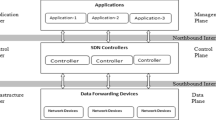Abstract
Asynchronous transfer mode (ATM) tends to be the most mature infrastructure to serve the imminent media broadband networks and is intended to eliminate network latency and improve traffic output versatility. In Weighted Round Robin (WRR) scheme, the main cause of concern is the delay that is being caused by high volumes of workloads at the wireless source nodes. In this paper, proposed an efficient intelligent time slice based round Robin scheduling algorithm for ATM with the use of integrated speed bit protocol (ISBP). The intelligent time slice offers priority, the blast of the CPU, and the time meaning transfer. The speed bit manager is maintained by the ISBP that contains prioritized objects. Then the intelligent time slice is done to generate the quantum time value. The purpose of this paper to enhance network performance in ATM networks by improving the throughput and average end-to-end delay. The new proposed scheme also offers a significant reduction in the average end-to-end delay when compared to the existing WRR scheme.









Similar content being viewed by others
References
Khalil E. A. (2012). Comparative performance of high-speed networks carrying multimedia. International Journal of Engineering Sciences and Emerging Technologies, 3(1), 9–21.
Agarwal, S., & Gautam, A. K. (2012). Alternate Multi Path Routing Architecture for ATM Networks. International Journal of Computer Science and Communication Engineering, 1(2), 37–42.
Mishra, B., Baudha, S., & Pandey, S. (2012). Changing data rate during handoff in GSM–ATM networks. International Journal of Advanced Research in Computer Engineering and Technology, 1(3), 170–176.
Ojesanmi, O.A. (2011). Asynchronous Transfer Mode (ATM). Georgian Electronic Scientific Journal: Computer Science and Telecommunications, 6.
Bali, V., & Rathore, R. S. (2010). Performance analysis of priority scheme in ATM network. International Journal of Computer Applications, 1(13), 26–31.
Shanmuganathan, C., & Raviraj, P. (2012). Performance measures of wireless protocols for ATM networks. International Journal of Mobile Network Communications & Telematics, 2(2), 31–44.
Sasirekha, V., & Chandrasekar, C. (2011). Enhancing security in atm networks through congestion control technique. Journal of Computer Applications, 4(2), 63–67.
Subhransu S. K. (2014). ATM congestion control & call admission control using admission factor and DIFA (Database Info Fuzzy Logic). International Journal for Science and Emerging Technologies with Latest Trends, 17–21.
Bhatia, K., Pal, A.K., & Anu Chaudhary. (2009). Performance Analysis of High-speed Data Networks Using Priority Discipline. BVICAM’s International Journal of Information Technology, 1(2).
El-Madbouly, H. (2007). Bandwidth allocation in ATM Network for different QOS Requirements. International Journal of Electrical, Electronic Science and Engineering, 1(8), 68–71.
Huang, S.-J., & Lin, C.-C. (2014). Application of ATM-based network for an integrated distribution SCADA-GIS system. IEEE Transactions on Power Systems, 17(1).
Susmi R. (2010). An enhanced genetic algorithm for dynamic routing in ATM networks. Journal of Theoretical and Applied Information Technology, 16(2), 153–159.
Agarwal, S., & Gautam, A.K. (2012). Alternate multi path routing architecture for ATM networks. International Journal of Computer Science and Communication Engineering, 1(2), 37–42.
Riaz Ahamed, S.S. (2008). The role of ATM technology in future data communication systems. Journal of Theoretical and Applied Information Technology, 624–628.
Sreenivasulu, M., Prasad, E. V., & Raju, G. S. S. (2011). Performance evaluation of rate based congestion control schemes for ATM networks. International Journal of Computer Science and Network Security, 11(6), 190–196.
Usha Rani, M., & Sailaja, K. (2013). Implementation of fast restoration mechanisms in ATM networks. International Journal of Advanced Research in Computer Science and Software Engineering, 3(7), 1299–1306.
Zheng, Q. (2013). An enhanced timed-round-Robin traffic control scheme For ATM networks. IEEE.
Srirm, K. (1992). Methodologies for bandwidth allocation, transmission scheduling, and congestion avoidance in broadband ATM networks. IEEE.
Gupta, S., & El Zarki, M. Traffic classification for round-Robin scheduling schemes in ATM networks. IEEE.
Oladeji, F., Oyetunji, M., & Okunoye, O. (2012). CWRR: A scheduling algorithm for maximizing performance of quality of service network router. International Journal of Computers and Applications, 41(2), 30–34.
Sreenivasulu, M., Prasad, E. V., & Raju, G. S. S. (2011). Enhanced ERICA congestion control scheme for ATM Networks. International Journal of Computer Science and Network Security, 11(5), 133–140.
Mohanty, R., Himansu S. B., Khusbu P., Monisha D., & Lakshmi P. M. (2011). Priority based dynamic round robin (PBDRR) algorithm with intelligent time slice for soft real time systems. arXiv preprint arXiv:1105.1736.
Jamin, S., Peter D. B., Scott S., & Lixia Z. (1995). A measurement-based admission control algorithm for integrated services packet networks. ACM, 25(4).
Wu, H., & Xinjun W. (2016). ISBP: Understanding the security rule of users' information-sharing behaviors in partnership. PloS one, 11(3), e0151002.
Author information
Authors and Affiliations
Corresponding author
Additional information
Publisher's Note
Springer Nature remains neutral with regard to jurisdictional claims in published maps and institutional affiliations.
Rights and permissions
About this article
Cite this article
Gaddam, S.V.K., Lobial, D.K. & Lal, M. An Efficient Intelligent Time Slice Based Round Robin Scheduling Algorithm for ATM Using ISBP. Wireless Pers Commun 122, 1–21 (2022). https://doi.org/10.1007/s11277-021-08806-4
Accepted:
Published:
Issue Date:
DOI: https://doi.org/10.1007/s11277-021-08806-4




